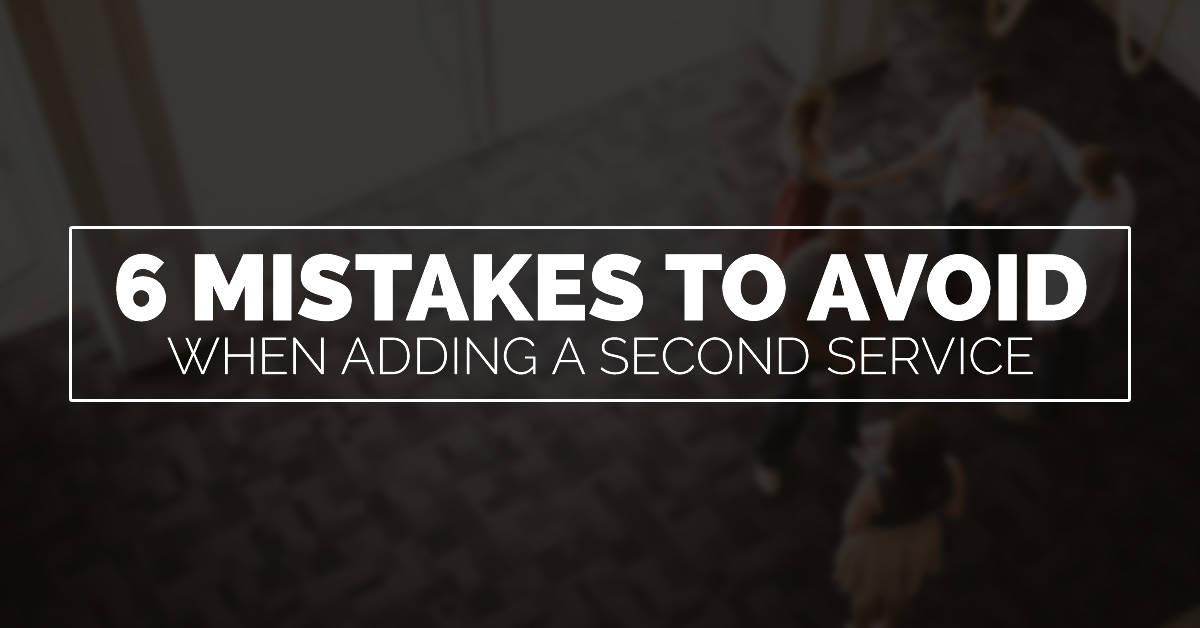
08 Feb 6 Mistakes To Avoid When Adding A Second Church Service
Adding a second service to your weekend gathering can be one of the scariest things for a church to do. Yes, it’s exciting that your church is growing and you need to have some more space, but despite the fact that many churches across America have added multiple services, there is still a very high failure rate.
Or maybe your church has already tried adding a second service and it just didn’t work. You were excited, your staff were excited, and your congregation was excited. But now that it fell flat on its face, you are terrified of giving it a second go.
Churches that fail when trying to add a second weekend service usually fall victim to making these 6 common mistakes.
Mistake #1 – Overextending Leaders
While launching a second service is exciting, many churches forget that this change will bring a much bigger demand on the leadership team. Before the church expands to a second service, they need to make sure that they expand their team of leaders as well. Failure to do so will result in burned out leaders.
Make a quick mental list of all that needs to be done for one service. The hours of sermon prep, the number of greeters, time dedicated for the worship experience, etc. And now double it. That will help to give you a much more realistic expectation on how you need to prepare before launching your service.
For a lot of smaller churches, adding a second service places a demand on both the worship and children’s ministry that far exceeds what a lay leader has time for. In order to correctly handle this transition to two services, you should consider hiring (at least part time) both a worship and children’s director.
Now one last tip that can help you navigate the demands of adding another service is to make both of your services identical. If the pastor only needs to prepare for one message, the worship team only needs to select one set of songs, and the children’s workers only needs one set of curriculum, you’ll greatly decrease the demand on your leaders and set yourself up for success.
Mistake #2 – Don’t Create Enough Time To Connect
When the idea of a second service is presented to a church, usually the number one complaint is: “But we won’t get to see our friends who attend the other service!”
That’s a valid concern.
One that has caused many of second services to fail before they ever really got started.
But it doesn’t have to be this way!
It is possible to allow just as much connection time between the two services as before if done correctly. But it does require you to schedule in time for people to make connections between your two services.
These three elements will help to promote making connections between services:
- Time – Allow for 30-45 minutes between your first and second service so that those who are leaving can spend some time with those who are coming.
- Space – You need to have a “mingle space” large enough that people don’t feel crammed or in the way. Once people feel like they are always in the way of others, they won’t take the time to connect with other people. As a rule of thumb, you should provide a space equivalent to about 50% of your auditorium for people to stay and connect.
- Food – Connections always seem to happen around food so make sure that your host team is on point, making sure there is fresh coffee and some sort of food. This creates an environment where people are relaxed and more open to talking with others.
Mistake #3 – Make The Second Service A “Second Class” Service
If the people in your church feel like your newly added service is of less quality than the original one, then guess which service they won’t want to come back to.
While not intentionally done, this is the downfall of many churches when adding a second service. Sometimes it happens for lack of preparedness and sometimes it’s just someone’s personal preferences. All the more reason to make both of your weekend service identical.
Here are some of the top reasons why people might feel that a service is second class:
- Music is not as good.
- New service doesn’t provide all the ministry programs as the first
- Baptisms, baby dedications, and other special events are reserved for the larger original service.
- The old service time is the same; while the new service is at another time deemed “less convenient”. (In order to avoid this from happening, a good rule of thumb is to change the times of both services).
Mistake #4 – Making The Service Too Early
Let’s be honest, there are not many people who would volunteer to wake up, get ready, and be at church a lot earlier than they already are. As a matter of a fact, most people in your church probably have a problem making it there on time to begin with.
When churches choose to add another service, they tend to lean towards making the service time earlier. I mean after all, God-forbid we miss the football kickoff.
In today’s culture, it’s not just teens and college students who don’t want to get up early. Early services are often very difficult for families as well to try to get their kids up, bathed, fed, and to church on time.
In most all areas of the countries, services that start at 9:00AM or after are better attended. Another great reason why it’s a benefit to move both of your services to new times.
Mistake #5 – Draining The Room Energy
Another very common reason that newly launched second services fail is because the energy in the auditorium is closely related to the number of empty seats. When people show up to this new service time and see that the auditorium looks close to empty, they begin to feel awkward and they move from being participants in the service to observers. They can also easily start to believe that they must be missing something better in the other service.
As a general rule of thumb, auditoriums feel full when 70% of the seating capacity is taken up. And when less than 50% of seats are filled, the room begins to feel empty.
How To Fix This?
Make sure that you set up your seating accordingly to how many people you expect. If you think that 100 people will show up, set up around 125-150 chairs. If you think that 300 people will come, set up around 375-425 chairs.
You can also use lighting to your advantage in making a room appear to be smaller and more filled than it actually is. Focus your light on only one section of a room and allow the rest of the room to remain darker.
Mistake #6 – Failing To Communicate Effectively
With all of the other details that need to be planned in order to add a service, communicating effectively this change is one aspect that can be easily overlooked. However, failing to do so can be the single biggest factor that causes your second service to fail.
When planning to launch a second service, there are usually three main areas where church fail to communicate effectively.
1. Communicate The Need/Vision
When announcing the addition of a second service, many churches end up making it sound like a sales pitch. It will be more convenient, you’ll have more options, etc. When this is the only reason given, no wonder nobody shows up. There is no NEED, no URGENCY.
Convince them on something that they have already bought into–your vision! You’re not adding a service to increase comfort. You need more space to reach people for Christ. Allow your people to join you on this mission and serve others by moving to your new service.
2. Communicate Extensively
Writing down your new service times in your bulletin and making a quick announcement from the stage is not NEAR enough to create the kind of excitement and momentum needed for this new service. You need to begin thoughtfully promoting this new service months in advance.
And we’re not just talking about announcing it from the platform every week. Once people get used to hearing or seeing the same message, they automatically begin to tune it out. Be creative and use a variety of avenues to promote your service.
Here are a couple examples of how you can creatively promote your new service.
- Promote new service times on slideshow before and after service
- Promote regularly on all social media platforms
- Incorporate video
- Email member database
- Meet with volunteers to give vision and prepare them for change.
- From the stage
3. Communicate To Key Leaders/Influencers
One thing you cannot underestimate is the need to create buy-in for adding your new service. If you can’t get your people to see the benefit and buy-in, you’re service is not going to go anywhere.
Start seeking buy-in from your key leaders and influencers in your church. If you can get them on board, they will be able to leverage their influence in bringing about change and help to motivate those who are hesitant or stubborn towards change.



